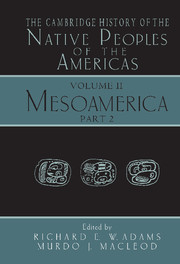
- Cited by 3
-
Cited byCrossref Citations
This Book has been cited by the following publications. This list is generated based on data provided by Crossref.
Diamond, Jared and Bellwood, Peter 2003. Farmers and Their Languages: The First Expansions. Science, Vol. 300, Issue. 5619, p. 597.
Trigger, Bruce G. 2003. Understanding Early Civilizations.
Del Angel-Pablo, Alma D. Juárez-Martín, Ana Itzel Pérez-Rubio, Gloria Ambrocio-Ortiz, Enrique López-Flores, Luis A. Camarena, Angel E. and Falfán-Valencia, Ramcés 2020. HLA Allele and Haplotype Frequencies in Three Urban Mexican Populations: Genetic Diversity for the Approach of Genomic Medicine. Diagnostics, Vol. 10, Issue. 1, p. 47.
- Publisher:
- Cambridge University Press
- Online publication date:
- March 2008
- Print publication year:
- 2000
- Online ISBN:
- 9781139053464




